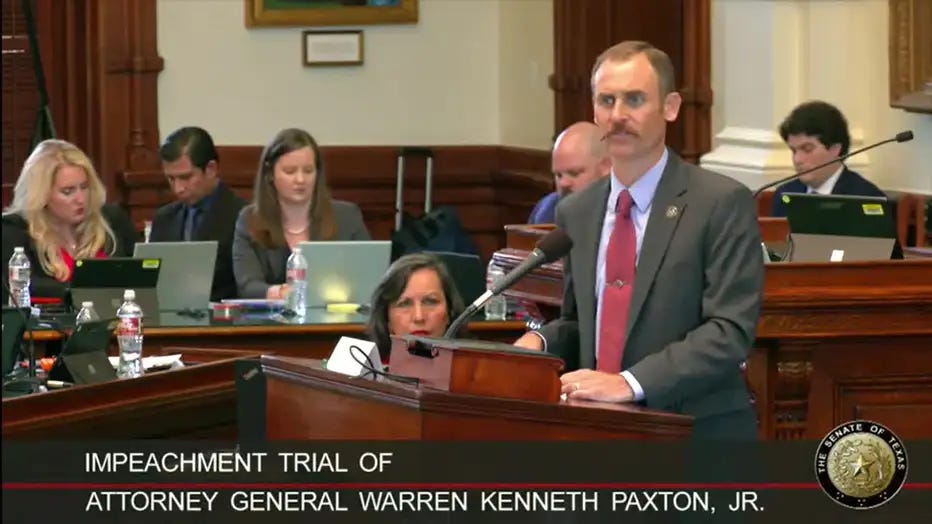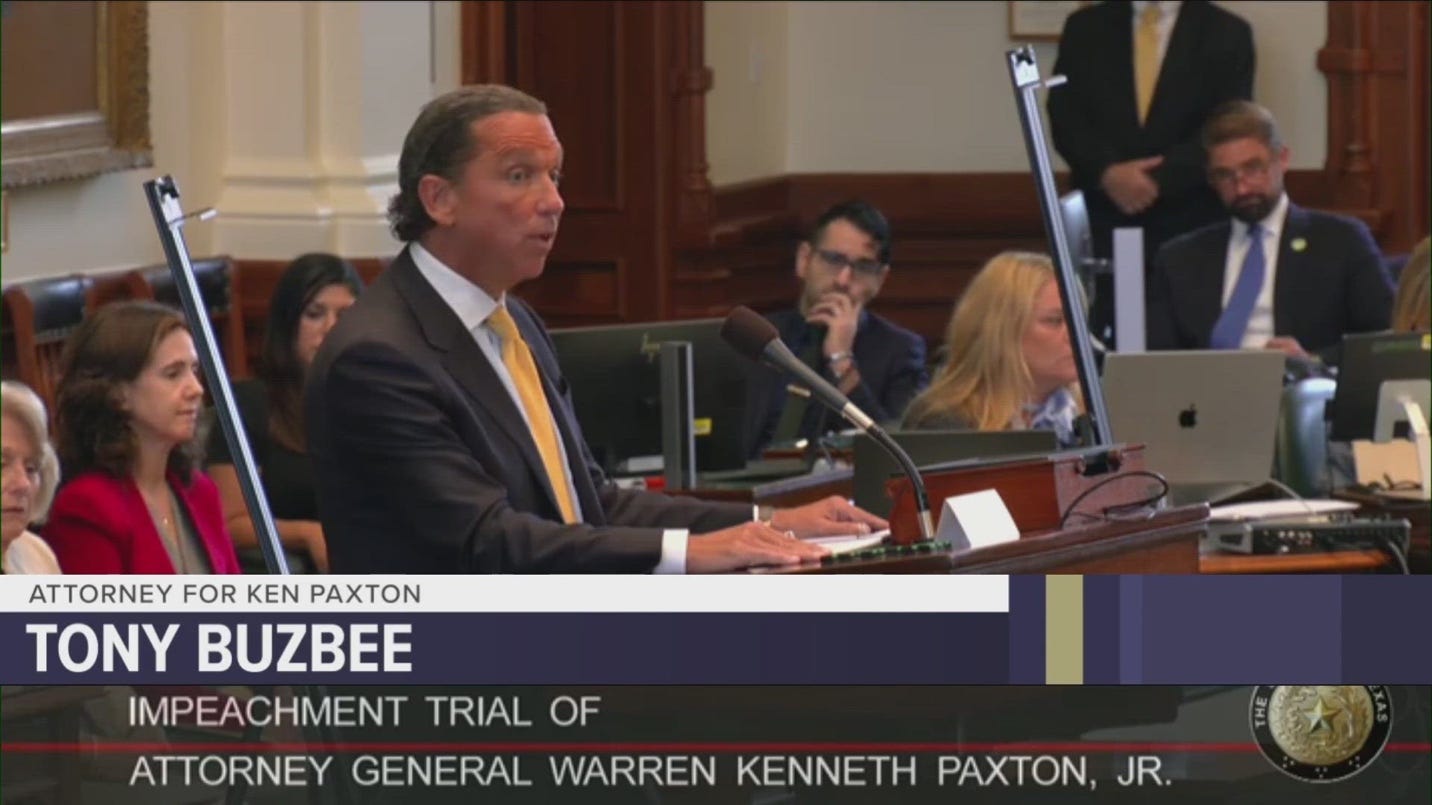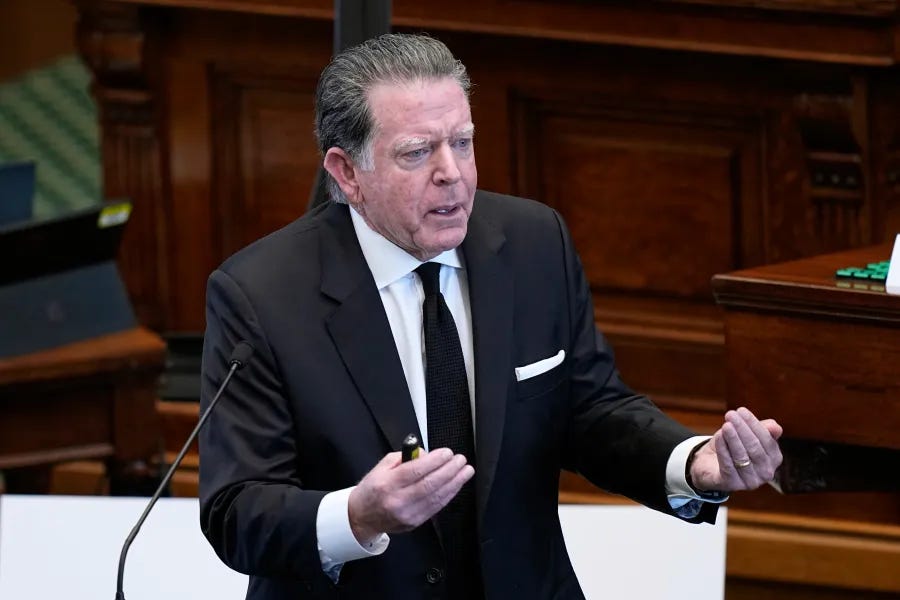Recap: Ken Paxton Impeachment Trial, Day One
Ken Paxton didn’t get anywhere close to getting the charges dismissed, which should make him nervous. Now we listen to testimony and evidence.
Welcome to our special coverage of the impeachment of Attorney General Ken Paxton here at Life Its Ownself! Please subscribe and encourage others to do so. Your support inspires me to write and publish regularly. All my content is free, but your paid subscription is a big affirmation. Please let me know how I’m doing by 1) liking, 2) subscribing, 3) sharing with others, and 4) commenting below.
(The Senate Chamber sits empty, awaiting the beginning of the Ken Paxton impeachment trial.)
Tuesday, September 5, 2023, 7:00 p.m.
Day One of the Impeachment Trial of Ken Paxton ended early, a combination of senatorial exhaustion and a few complex evidence issues for which Dan Patrick and his legal advisors have yet to formulate a consistent policy. The trial resumes tomorrow at 9:00 a.m. Here are today’s highlights.
I. Preliminary Motions to Dismiss Articles
The most important part of the day was this morning’s session during which the 30 senators voted on 16 motions by the Paxton defense team to dismiss one or more of the 20 Articles of Impeachment against him. Dismissal of some charges would be a good sign for Paxton, but it was not to be. In fact, none of the motions won, and most lost convincingly.
Now, prior performance does not predict future results; today’s votes may mean only that members want the witnesses and evidence to come out (which in itself is bad for Paxton). No senator has already made up their mind, and for good measure they took an oath to that effect just this morning.
Just for fun, though, let’s do the math: Paxton needs only to be convicted on one charge to be expelled from office. There are 31 senators; 21 votes are necessary to convict Paxton on any of the charges.[i] All the Democratic senators voted against each motion to dismiss. The 19 Republican senators broke down like this:
Six senators voted for every motion to dismiss: Paul Bettencourt, Donna Campbell, Brandon Creighton, Bob Hall, Lois Kolkhorst and Tan Parker. These should be considered Paxton’s most loyal votes.
However, seven senators voted against every motion to dismiss: Pete Flores, Kelly Hancock, Joan Huffman, Phil King, Mayes Middleton, Robert Nichols and Drew Springer. If you add them to the 12 Democrats, that means there might be 19 senators who’d vote to convict on at least one article.
Which leaves five GOP senators who voted for on some motions and against on others: Brian Birdwell, Bryan Hughes, Charles Perry, Charles Schwertner and Kevin Sparks. If two of them break ranks on a particular article, that would be enough to convict Paxton.
Of course, it is not that simple. The seven senators who voted against and the five “swingers” are, as you read this, getting phone calls from big and little donors, neighbors, and politicians angling to take their seats. The pressure will be relentless from the MAGA wing of the Texas (and national) GOP for whom Ken Paxton is a hero.
It’s tough to make predictions, especially about the future, but I would not be reassured if I were Ken Paxton.
II. Opening Statements from the Parties
After that came opening statements from the parties. Representative Andrew Murr (R-Lum’s Barbecue), the head of the House Impeachment managers, delivered a 17-minute speech summarizing the House’s case against Paxton. The gravamen of his argument: the purpose of the impeachment is not to punish Paxton, but to protect the state from an elected official who has violated his oath of office, which is “literally an oath to God.” “In Texas, we require more from our public officials than merely to avoid being a criminal.”
Paxton lawyers Tony Buzbee and Dan Cogdell then spent an hour criticizing the impeachment as slapdash, inaccurate and “led by a drunken Speaker seeking political vengeance.”
They argued that impeaching Paxton would overturn the will of over four million voters: “Is it up to the voters or is it up to politicians to see who stays in office?” They also promised to puncture someof the more well-known Paxton transgressions, saying he’d paid for his home remodel and that Laura Olson (the mistress) was not hired through Paxton’s intervention.
(Dan Cogdell during his opening statement on the floor of the Senate.)
III. The Testimony and Evidence Begin
After that, the House managers began to present their case. House lawyer Rusty Hardin called Jeff Mateer, who had been Paxton’s First Assistant AG – essentially, the day-to-day head of the agency. Mateer started by burnishing his conservative credentials. He is a devout Christian and Federalist Society member who works for the First Liberty Institute, which fights for religious freedom (as long as that religion is nationalist Christianity.)
“On a scale of 1-10, how conservative do you consider yourself?” asked Hardin. “Eleven,” was the reply. “Are you a RINO?” asked Hardin. No, said Mateer.
Mateer’s testified that over the course of 2020 he became aware of, and alarmed by, Ken Paxton’s personal interest in the legal entanglements of Nate Paul, including his desire to make an appearance at a court hearing on Paul’s behalf. “The Attorney General just doesn’t go to court – that’s why we have 700 lawyers in the office.”
Mateer’s testimony soon bogged down over objections about executive and attorney-client privilege issues. Finally, Dan Patrick called a halt for the day so that the parties and his legal advisors could hash them out. The issues are straight-up nerd bait, but their resolution will affect the House’s ability to present its case: its key witnesses were all high-level OAG employees, and if Paxton’s team can muzzle them the case for impeachment will lose a lot of steam.
IV. Some Impressions
Paxton’s lawyers have adopted a hard-charging, take-no-prisoners approach – loud, aggressive, over the top. But the Senate is a cool institution – outwardly placid, unruffled, even torpid. I would not be surprised if the Buzbee/Cogdell style begins to get on senators’ nerves.
Dan Patrick seems to be trying to keep the ball in the middle of the fairway. He excused Paxton from being called to testify, but his other rulings were fair. What’s going on behind the scenes is anyone’s guess, but he is succeeding in looking impartial.
Ken Paxton, by the way, returned the favor by disappearing as soon as he’d entered his pleas. A Paxton trademark: he hides behind his lawyers, saving his public statements for the political red-meat crowd. (This helps explain why Mateer was so freaked out by Paxton’s plan to actually show up in a courtroom.)
This is the Trial of the Century, but you would not be able to tell by going to the Senate Gallery today. They’d set up a process where you must be in line to claim a ticket, but there was no line, and plenty of seats seemed available. One friend guesstimated the gallery was no more than half full.
This is going to be a slog. Sessions are to last from 9-6, but I think the senators will balk at having to sit still that long. (I certainly will!) Both sides are limited to a total of 24 hours of testimony, cross-examination, and rebuttal each, but I do not think it will pass quickly.
I will publish another special edition of Life Its Ownself after tomorrow’s session.
[i] Senator Angela Paxton is prohibited from deliberating or voting on the charges but is counted for the purpose of attendance; hence, 21 votes to convict.








Ditto on CD Bush’s comment. i had to miss the opening statements but may listen later tonight. As for the pressure tactics from the boys out west, I think Molly Ivins and Billy Lee Brammer have some colorful advice about political survival.
This Buzbee dude...not a fan. Mateer is holding his own today.